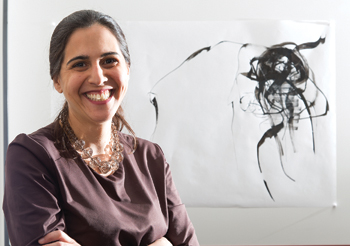Liberal Arts Superheroes
Science-minded Swarthmoreans have not-so-secret artistic identities

Nazanin Moghbeli ’96 creates her Iranian-calligraphy-inspired paintings using ink and bamboo pens. She recently spent more than three hours on campus, getting suggestions and insights on her latest work from the List Gallery’s Andrea Packard ’85 and her former art professor, Randall Exon. Photo by Laurence Kesterson
Recently, Nazanin Moghbeli ’96 was painting alongside her 6-year-old son when he told her she was a superhero. “Your regular identity is a doctor,” he said, “But your secret identity is a painter.” For the artist-cardiologist, it was the ultimate compliment. Balancing her painting with her work at Albert Einstein Medical Center in North Philadelphia is challenging, but she manages—waking up at 5 a.m. to paint for an hour and a half each morning before her three young children awaken.
Moghbeli’s seemingly disparate interests—art and medicine—are cohesive in her mind, and she melds them into all aspects of her life.
“I think about art when I’m at work. I talk to patients about creating something or about what they find beautiful,” says Moghbeli, who often treats people with heart failure and at the end of their lives. “Art can be a sustaining force when people are so ill; it connects them to something bigger than just today and tomorrow,” she says.
Moghbeli’s art-science synthesis began when, as a first-year student, she saw biology professor Scott Gilbert comparing the creation of an embryo to the creation of art.
“I really loved painting outdoors, and that tied in very naturally with my biology studies,” Moghbeli says. “I remember walking to my studio to paint as a break from studying for a chemistry exam. It sustained me to do my art and science together.”
Jove Graham ’96, a double theater and engineering major, also took advantage of Swarthmore’s liberal arts mindset, cramming in as many acting classes as he could alongside his mechanical engineering requirements. The herculean effort for a double B.A. and B.S. major takes its own kind of superhero—a feat of academic strength Graham attributes to serendipitous scheduling.
“Fortunately, the engineering classes met first thing in the morning, and the theater classes were mostly afternoons and evenings,” says Graham, now the director of clinical research project development at the Geisinger Center for Health Research in Danville, Pa.
Like Moghbeli, Graham also sees his fields of study as seamlessly fused.
“In both cases, you’re trying to solve a problem in the most interesting way,” Graham says. “There’s maybe a little more art in the theater, but you have to get pretty creative in a scientific job, too—using limited resources to do something elegantly and efficiently.”
Graham, who graduated with distinction in engineering, took every opportunity to pursue theater as a student—he even taught acting to 9- to 12-year-olds during the summers at a Malvern, Pa., theater camp. When it came time to settle on a profession, he went out on a limb to take a “bottom-of-the-totem-pole” job with a Philadelphia theater, deferring his acceptance into UC–Berkeley’s bioengineering Ph.D. program for a year while deciding whether or not to stick with the theater gig. In the end, science won out.
“I had always hoped that there’d be time to do theater in between. Luckily, that’s how it’s turned out,” Graham says.
Nowadays, Graham spends most evenings directing or acting in shows with a community theater in his small north-central-Pennsylvania town. As a theater board member, Graham also manages marketing and communication for the group, which has seen radically escalated turnout at its auditions in his two-year tenure.
Reflecting back, Graham, like Moghbeli, cites an unidentifiable something about Swarthmore that fosters a liberal arts approach to thinking and life. “I didn’t feel different from anyone else on campus,” says Graham. “Everybody I knew had something else that they were doing—my something else just happened to be a theater major.”
To see Moghbeli’s art, go to www.nmoghbeli.com
 Email This Page
Email This Page